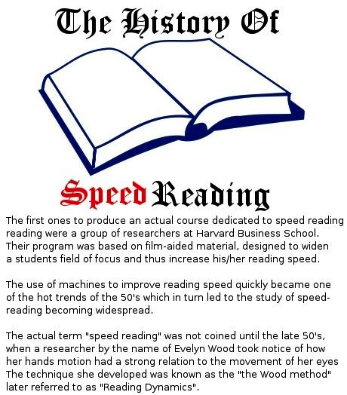Overview
I’m an avid reader, but to be honest I often lament how slowly I move through books. I wish I could digest them faster so that I can incorporate the lessons they offer into my life. In the interest of co-learning, today I’m going to do some research so that I can put together a beginner’s guide to speed reading. I hope you enjoy!
What is Speed Reading?
 The dictionary defines speed reading as the ability to “read rapidly by assimilating several phrases or sentences at once.” For students especially, this technique can come in handy when your professor asks you to read and digest 100+ pages of textbook material before tomorrow’s test.
The dictionary defines speed reading as the ability to “read rapidly by assimilating several phrases or sentences at once.” For students especially, this technique can come in handy when your professor asks you to read and digest 100+ pages of textbook material before tomorrow’s test.
The most boastful speed readers out there today claim they can read at rates upwards of 1,200 words per minute, which is a considerable jump from the average reading rate of 200-400 words per minute. There’s some dispute over these claims, but there’s no doubt in my mind that there’s a considerable gap between 400 and 1,200 words per minute, so it makes me think there’s a possibility to improve, even if I never reach a rate close to 1,000 words per minute.
Advocates of speed reading believe that the ‘sound-it-out approach’ that most of us learned when first being taught how to read actually slows us down. In other words, saying each word inside your head as you read it takes time. Thus, speed reading experts claim that abandoning the vocalizing of words (even if we’re doing so silently in our heads) is the first key to speed reading.
Methods of Speed Reading
There is no one tried and true technique used by speed readers all over the world. There are actually several methods, including skimming, meta guiding, and Rapid Serial Visual Presentation (RSVP), among others. Let’s take a few minutes to break down these three popular methods.
Skimming
Skimming is when you glance over a larger body of text to find the important information. While this is generally regarded as speed reading, there is some controversy over whether this method actually teaches you to read faster or whether it simply teaches you to skip over parts of the text that aren’t relevant or useful. Many studies actually show that you aren’t able to recall many details when using the skimming technique.
Meta-Guiding
Meta guiding is an older method of speed reading. It involves utilizing a finger or a pointer (such as a pen) to guide your eyes to specific words in a body of text. The theory behind meta guiding is that it minimizes distractions and helps you focus on certain words in order to increase your reading speed. Another method suggests reading multiple lines of text at a time by expanding your peripheral vision.

Rapid Serial Visual Presentation (RSVP)
The RSVP method is utilized by newer digital speed reading systems. These systems flash single words on a screen so you’re only concentrating on one word at a time. As your ability to see and digest these words increases, you can speed up the rate at which the system displays these words. Once such example of an RSVP system is Spritz.
Speed vs. Comprehension
The biggest question for many is whether speed reading is the preference of quantity over quality. In other words, are speed readers comprehending and retaining as much critical information as readers using more traditional methods?
While reading speed is certainly one criterion, your ability to comprehend is also dependent on the breadth of your vocabulary and degree of experience with the subject matter. Speed reading can, in fact, increase comprehension, but if you’re skimming material that uses words you’re unfamiliar with, the speed with which you read could actually negative impact comprehension.
Unfortunately, there is limited research in this area, but one study suggests that our physical ability to move our eyes may actually limit our ability to speed read. This study states, “To understand text you need to move your eyes to put the fovea on the part of the text you want to focus. Acuity drops off pretty markedly outside the fovea and you can’t discriminate the words and text far from the fovea.”
It appears that certain physical limitations may actually hinder our ability to comprehend through speed reading, but even the publisher of the above study admits that “you can probably push yourself to get a little over 500 words per minute.”
Who May Be Best at Speed Reading?
Some suggest that those of us who like to multi-task may be best suited for speed reading because it requires our eyes and brains to process many things at once. Speed reading also requires intense, sustained concentration.
Proponents claim that the best speed readers are absorbing text, processing information, detecting the author’s main ideas, clueing into the author’s style to decipher themes over ‘fluff’, and adding perspective to separate the ‘meaty details’ from the lighter stuff. All this is happening simultaneously at a very fast rate.
What Materials Are Best for Speed Reading?
While there’s still quite a bit of debate over the true effectiveness of speed reading, some researchers have suggested that certain reading material may be best suited for speed reading. This type of material includes news stories and emails, as they don’t often require total comprehension.
Give it a Try!
If you’ve been searching for some tips on improving your reading speed, now’s the chance to give these a try. Given that I’ve only researched the information presented above online, I’d love to hear how it actually works in practice for some of you!
Fortunately, there are a number of apps and speed reading tests available online today. Some of these apps include Spreed, Outread, Velocity, and Syllable. It is my sincere hope that, by increasing reading speed and comprehension, we can make ourselves better writers through the breadth and depth of information we are able to consume. After all, the more we learn about the world, the more we can share!
Please leave a comment below if you are inspired, perplexed, saddened, or angered by any of the ideas presented above. I welcome any and all comments and will do my best to respond in a timely fashion.
I’d also encourage you to share this with others if you found it particularly insightful or helpful. Be sure to tag @ballisterwriting on Facebook or Instagram if you do! The point of social media, after all, is to be SOCIAL! I don’t need followers or likes, but I’d like to contribute to a real conversation about how we continue to improve as a society and as individuals.
Happy Reading!
Tucker Ballister

Very interesting post. I absolutely love reading, but I do feel I read rather slowly. I must say that comprehension is a top priority for me, and enjoyment would probably be the second priority.
But it seems like the meta-guiding practice could work to speed up reading and even help with comprehension, by adding a focus. I’ll have to give that a try!
I’m glad you found it useful! And I agree that comprehension is my second priority as well. But I also think the way we can read and consume books can depend on the type of book. Some may be better-suited for speed reading, and vice versa.